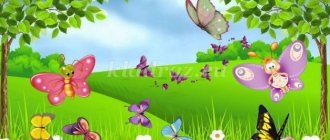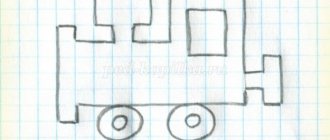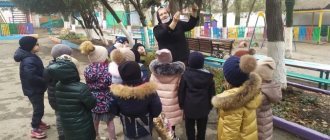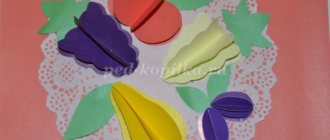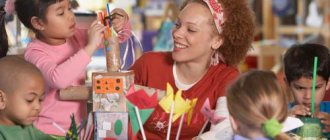Lesson on FEMP in the middle group on the topic “Ball and Cube”
Lesson on FEMP in the middle group on the topic “Ball and Cube”
Goals and objectives:
1.Introduce geometric bodies - cube and ball.
2. Learn to examine them using a tactile-motor method.
3. Give an idea of stability and instability, the presence or absence of angles.
4. Practice counting by ear within five.
5. Consolidating knowledge about the geometric shapes of a circle and a square.
Materials: round and cubic objects. Tambourine, toy Krosh (hare), suitcase for toys, cards with images of 1 to 3 objects, basket.
Preparatory work: repeat geometric figures of round and square shapes, repeat the counting within 1-3, exercise in counting by ear within 1-3.
Progress of the lesson.
Teacher-defectologist: Hello guys! Look, Krosh came to visit us with a large suitcase.
Krosh: Hello, friends! My friend Losyash was in a hurry to a very important meeting, which he forgot about. They called him and he left urgently. He asked me to look after the suitcase with toys. And he let me play with them. I'm very bored alone. Play with me?
Teacher-defectologist: Guys, let’s play with Krosh?
Children's answers: Yes, of course! We are very glad to see you, hello Krosh!
Teacher-defectologist: Krosh, let's see what's in the suitcase? Yes, the toys are all in disarray, mixed up. (Pours them into the basket) Oh! There are two more baskets! Look - on one there is a circle, and on the other there is a square. What would that mean?
Children - you can put toys in baskets...
Krosh - what toys should we put in the basket with the square?
Children are cubes because cubes look like a square.
Krosh – what should we put in the basket with the circle then?
Children are balls! Because they look like a circle
Teacher-defectologist: Good! Let's Play! Line up in pairs and split into two teams. Guys, we need to divide into two teams and stand behind each other. At the signal, the first team must bring balls, and the other - cubes.
Ball and cube game
Teacher-defectologist: Have we divided the toys correctly?
Discussion of the results of the game.
Krosh: Let's play some more! I know a game called "Ride through the Gate."
Game "Ride through the gate"
Teacher-defectologist: Guys, do you want to play some more? Then divide into two teams!
Guys, one of you will take a cube and the other a ball. And at the signal, roll the objects into the gate.
Children, at a signal, begin to move objects, trying to roll them through the gate faster.
The child with the ball gets to the goal faster. But when the second child “rolls” the cube, the teacher praises both and calls another pair of children. Invites them to choose the item that they will advance to the gate.
Usually everyone tries to take the ball, since they saw that in the previous game the child with the ball reached the ending faster.
Other pairs of children do the same.
Teacher-defectologist: Why are you all taking the ball?
Children's answers: A ball can stand and roll, but a cube can only stand; the corners prevent it from rolling.
Teacher-defectologist: Well done! What is the difference between a ball and a cube? Would a ball or cube roll better?
Children's answers: ball.
Teacher-defectologist: Correct, the ball is round and unstable. And the cube is stable. It has corners. This is a cube. (The teacher suggests finding objects in the shape of a ball and a cube in the group). Well done!
Teacher-defectologist: Look, Krosh has more cards in his suitcase. Let's look at them. Olya, what have you drawn? How many?
(each child is given a card showing 1 to 3 objects)
Teacher-defectologist: let me now hit the tambourine three times and those guys who have three objects on their cards go out into the circle. Now how many times did I hit the tambourine? Who's coming out? Did everyone come out right? Well done! Shall we play again?
Game "What has changed?"
A presenter is selected. At the signal, the leader leaves the circle and turns away. One of those who stood inside the circle stands in the circle. At the signal “What has changed?” The leader must name the child who stood in the circle. If he guessed right, he continues to be the leader; if not, stand in a circle and a new leader is chosen.
Teacher-defectologist: Let's stand in a circle, and Krosh will choose those who will stand in the circle. And we will choose the presenter according to a little counting rhyme:
One, two, three, four, five, the tiger went out for a walk. They forgot to lock him. One two three four.
Teacher-defectologist: What has changed? Who's not in the circle?
Krosh: Thanks for playing with me. My friend Losyash has so many wonderful toys, I especially liked these ones, I forgot what they are called.
Children: Cube and ball.
Krosh: I have to go. The elk has probably already returned. It's time to return the suitcase with toys. See you again!
Teacher-defectologist: Thank you Krosh
Reflection.
Summary of educational activities for studying mathematics in the middle group of preschool educational institutions
Tasks:
strengthen children's ability to count to 5; form an idea of equality and inequality of 2 groups of objects based on counting; consolidate the ability to distinguish between a ball, cube, and cylinder; consolidate the ability to distinguish between the left and right hand, determine spatial directions and denote them with words: left, right, forward, backward.
Visual material
: toys (5 pcs.), doll cups (5 pcs.), 3 chairs, figures (cube, ball, cylinder).
Handout
: figures (cube, ball, cylinder) according to the number of children.
Progress of the lesson
1 part. Game situation “Guests have come to us.” The teacher informs the children that toys have come to visit them (places 5 dolls). Finds out from the children what needs to be done to find out how many guests have arrived? Children's answers: “We need to count.” The teacher counts together with the children and makes a generalizing gesture and clarifies with the children: “How many guests have come?” Children: "5". The teacher offers to treat the guests to tea and put a cup for everyone. One child places cups in front of each toy. And he counts how many cups he placed (4). The teacher clarifies: “5 dolls and 4 cups - compare, which is bigger? (5 dolls are more than 4 cups). Compare 4 cups and 5 dolls, which is smaller? (4 cups less than 5 dolls). How can we make it so that there are equal numbers of dolls and cups?” Children discuss two ways to equalize objects: by adding or subtracting one object. The called child equalizes objects in one of the following ways. “How many dolls and cups are there?” - the teacher finds out. Then he restores the inequality and asks another child to establish equality in a different way. The teacher clarifies the formation of the number 5.
Part 2. Game exercise “Find your place.” The teacher puts three chairs and places geometric shapes on them (cube, cylinder, ball). Before the game, the teacher shows the figures, asks them to name the form and show what actions can be performed with them. The teacher shows the cube: - What is the name of the figure? (Cube). - That he has? (Sides and corners). - What actions can be performed with it? (Put). The teacher shows the ball: - What is the name of the figure? (Ball). - Does it have corners and sides? (No, it's smooth). - What actions can be performed with it? (Ride). The teacher shows the cylinder: - What is the name of this figure? (Cylinder). - How are a cylinder and a ball similar? (You can ride them). — How are a cylinder and a cube similar? (They can be installed). The teacher calls three groups of children and distributes figures to them and explains: - While I am knocking on the tambourine, you walk in different directions. As soon as the tambourine stops playing, you need to find your place. The game is repeated several times.
Physical education minute
The bear cubs lived in the thicket They twisted their heads Like this, like this (circular movements with their heads) They twisted their heads The bear cubs were looking for honey Together they rocked the tree (raise their arms up and tilt to the right and left) Like this, like this They rocked the tree together, And then they walked (walking like a bear) And they drank water from the river Like this, like this And they drank water from the river (the torso bends forward) And then they danced (springs with the torso turning left and right) They raised their paws higher (jumping, clapping their hands at the top) Like this, like this, raised their paws higher!
Part 3. Game exercise “Where will you go and what will you find?” The teacher hides toys familiar to the children in different places in the group. Then the teacher asks riddles: He slept in a fur coat all winter, He sucked a brown paw, And when he woke up, he began to roar. This is a forest animal... Children: “Bear.” Educator: - Well done, you guessed the riddle. Tell me, where is the bear to your right or left? Children's answers. Educator: - Listen to the next riddle. Freckled back. Oh, how awkward! And she blushed... Children: “Ladybug.” Educator: - Well done, you guessed the riddle. Tell me, where is the ladybug on your left or right? Children's answers. Educator: - Listen to the next riddle. In his garden, Andreika was watering flowers from... Children: “Water cans.” Educator: - Well done, you guessed the riddle. Tell me, where is the watering can in front or behind you? Children's answers. Educator: - Listen to the next riddle. This animal lives only at home. Everyone is familiar with this beast. Its mustache is like knitting needles. He purrs and sings a song, Only the mouse is afraid of him. Guess it? This is... Children: "Cat." Educator: - Well done, you guessed the riddle. Tell me, where is the cat behind or in front of you? Children's answers. At the end of the lesson, the teacher sums up the lesson.
Preview:
State budgetary preschool educational institution kindergarten No. 45 of compensatory type Krasnoselsky district of St. Petersburg
pedagogical event with middle group children
on the formation of elementary mathematical concepts
Topic: “Introducing the Cylinder Figure”
Ivanova Natalya Gennadievna
First qualification category
Goal: Formation of an idea of a cylinder as a geometric shape based on comparison with a ball.
Develop children's understanding of the variety of geometric shapes;
To develop the ability to compare geometric shapes and find objects of proposed shapes in the environment.
Enrich children's speech using mathematical formulations;
Develop fine motor skills and coordination of movements when performing tasks.
Develop a culture of behavior and the ability to complete the assigned task.
Forms of joint activities between adults and children:
